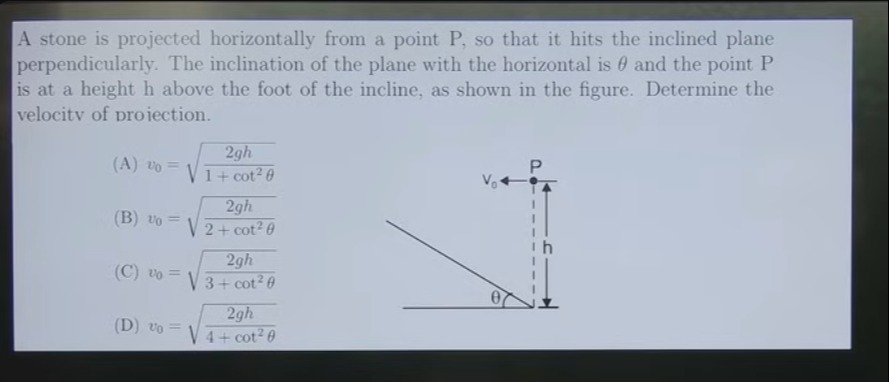Question
Question: A stone is projected horizontally from a point P, so that it hits the inclined plane perpendicularly...
A stone is projected horizontally from a point P, so that it hits the inclined plane perpendicularly. The inclination of the plane with the horizontal is θ and the point P is at a height h above the foot of the incline, as shown in the figure. Determine the velocity of projection.

A
v0=1+cot2θ2gh
B
v0=2+cot2θ2gh
C
v0=3+cot2θ2gh
D
v0=4+cot2θ2gh
Answer
(D) v0=2+cot2θ4gh
Explanation
Solution
Here's how to determine the velocity of projection:
-
Set up coordinate system: Let the point of projection P be the origin (0,0). Let the x-axis be horizontal to the right and the y-axis be vertically downwards.
-
Equations of motion:
- Initial velocity: u=v0i^ (assuming projection is to the right, towards the incline).
- Acceleration: a=gj^.
- Position at time t: x(t)=v0t, y(t)=21gt2.
- Velocity at time t: vx(t)=v0, vy(t)=gt.
-
Perpendicular impact condition:
- The stone hits the inclined plane perpendicularly. The slope of the velocity vector is mv=vxvy=v0gt.
- The inclined plane makes an angle θ with the horizontal and goes downwards to the right. So its slope is mplane=−tanθ.
- For perpendicular impact, mv=−mplane1.
- v0gt=−(−tanθ)1=cotθ.
- This gives gt=v0cotθ…(1).
-
Geometry of the setup:
- The point P is at a height h above the foot of the incline (F). Let the horizontal distance from P to the vertical line passing through F be L.
- In the right triangle formed by P, F, and the point vertically below P on the horizontal line of F, we have tanθ=Lh.
- So, L=hcotθ.
- The equation of the inclined plane, passing through F (L,h) and having a slope of −tanθ, is Y−h=(−tanθ)(X−L).
-
Point of impact:
- The stone hits the plane at (x,y). Substituting x=v0t and y=21gt2 into the plane equation:
- 21gt2−h=(−tanθ)(v0t−L).
- Substitute L=hcotθ:
- 21gt2−h=(−tanθ)(v0t−hcotθ)
- 21gt2−h=−v0ttanθ+htanθcotθ
- 21gt2−h=−v0ttanθ+h
- 21gt2=2h−v0ttanθ…(2).
-
Solve for v0:
- Substitute t=gv0cotθ from (1) into (2):
- 21g(gv0cotθ)2=2h−v0(gv0cotθ)tanθ
- 21gg2v02cot2θ=2h−gv02cotθtanθ
- 2gv02cot2θ=2h−gv02
- Multiply by 2g:
- v02cot2θ=4gh−2v02
- v02cot2θ+2v02=4gh
- v02(2+cot2θ)=4gh
- v0=2+cot2θ4gh.
